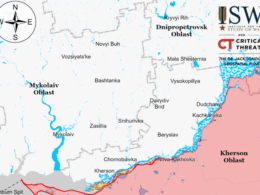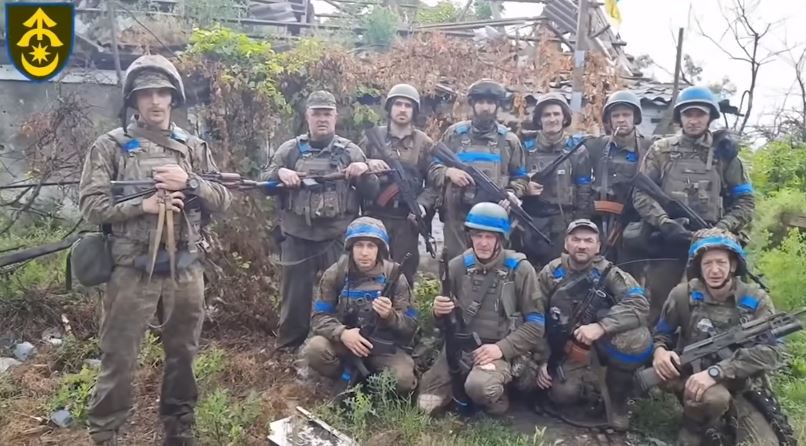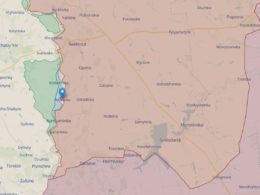Ukrainian forces reportedly conducted counteroffensive operations in five sectors of the front on July 5 and made gains in some areas.
Geolocated footage posted on July 5 shows that Ukrainian forces have advanced southwest of Berkhivka (6km northwest of Bakhmut), west of Yahidne (2km north of Bakhmut), and southwest of Bakhmut (1, 2, 3, 4, 5, 6).
The Ukrainian General Staff reported that Ukrainian forces conducted offensive operations south and north of Bakhmut, and Ukrainian Deputy Defense Minister Hanna Maliar stated that Ukrainian forces are advancing in an unspecified area on Bakhmut’s southern flank.
Ukrainian MP Yuriy Mysyagin stated that Ukrainian forces established a new position north of Opytne (6km northwest of the outskirts of Donetsk City) along the Avdiivka-Donetsk City front.
Russian sources claimed that Ukrainian forces conducted assaults in the Lyman direction, the Bakhmut direction, along the Avdiivka-Donetsk City front, on the border between Zaporizhzhia and Donetsk oblasts, and in western Zaporizhzhia Oblast (1, 2, 3, 4, 5
, 6, 7, 8, 9, 10, 11, 12, 13, 14, 15, 16, 17, 18, 19, 20, 21).
Ukrainian Deputy Chief of the Main Operational Department of the General Staff General Oleksii Hromov reported
on July 5 that Ukrainian forces have advanced 7.5km into Russian-controlled territory in western Zaporizhzhia Oblast and along the administrative border between the Zaporizhzhia and Donetsk oblasts. Hromov stated that Ukrainian forces have liberated nine settlements and 160 square kilometers of territory since the start of the Ukrainian counteroffensive on June 4.
Ukrainian forces reportedly conducted a series of missile strikes targeting Russian rear positions along the entire front overnight and during the day on July 5.
Geolocated footage published on July 4 indicates that Ukrainian forces struck an ammunition depot in Makiivka, Donetsk Oblast (6km northeast of Donetsk City).
A Russian milblogger claimed that Ukrainian forces struck a Russian fuel and lubricants depot in Makiivka and that Ukrainian forces are regularly launching missile strikes against rear Russian targets in Ukraine.
Geolocated images published on July 5 also show apparent Ukrainian strikes on Russian positions near Debaltseve (52km northeast of Donetsk City).
Geolocated footage published on July 5 also shows the aftermath of an alleged Ukrainian strike on a railway station in Yasynuvata (6km northeast of Donetsk City).
Geolocated images published on July 5 shows the aftermath of an alleged HIMARS rocket strike on a Russian occupation administration building in Volnovakha, Donetsk Oblast 35km southwest of Donetsk City (1, 2, 3, 4
, 5).
Russian milbloggers claimed that Ukrainian forces struck Russian positions near Yakymivka (16km southwest of Melitopol) and attempted to strike Berdiansk in Zaporizhzhia Oblast with Storm Shadow Cruise missiles.
Russian sources claimed that Russian air defense systems shot down a Ukrainian missile in the vicinity of Berdiansk.
A local Kherson Oblast Telegram channel also claimed that Russian air defenses were activated near Skadovsk, Kherson Oblast (60km southeast of Kherson City).
The footage and claims of these Ukrainian strikes suggest that Ukrainian forces launched a coordinated series of strikes aimed at degrading Russian logistics and ground lines of communication (GLOCs) throughout the theater. United Kingdom Chief of the Defense Staff Admiral Sir Antony David Radakin stated on July 4 that Ukrainian forces are conducting an operation to “starve, stretch, and strike” Russian forces to break down Russian defensive lines.
A widespread strike series targeting Russian GLOCs and logistics would be an appropriate element of such a strategy and is partially reminiscent of the interdiction campaign that Ukrainian forces conducted as a part of the Kherson counteroffensive.
ISW previously assessed that Ukrainian forces appear to be focusing on creating an asymmetrical attrition gradient that conserves Ukrainian manpower at the cost of a slower rate of territorial gains, while gradually wearing down Russian manpower and equipment.[17] A possible Ukrainian interdiction campaign supporting this effort would have cumulative effects, and its results would not be immediately evident.
Read also:
- Zelenskyy wished that Ukraine had started counteroffensive “much earlier” – CNN
- Frontline report: Russian defense crumbles near Bakhmut’s Klishchiivka as Ukrainian precision strikes target ammo, logistics
- Russian military formations from across Eurasia bear brunt of Ukraine’s counter offensive – UK intel
- Fierce fighting rages on along 1,200 km front line – Ukraine’s General Staff





